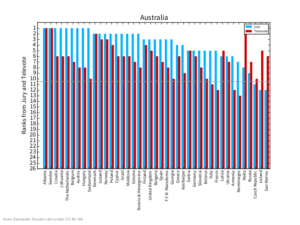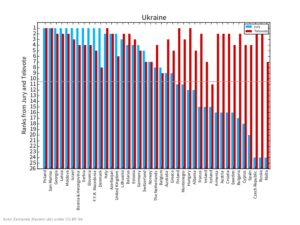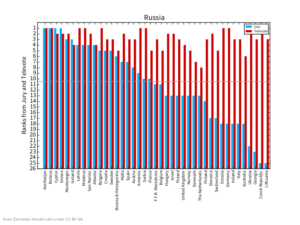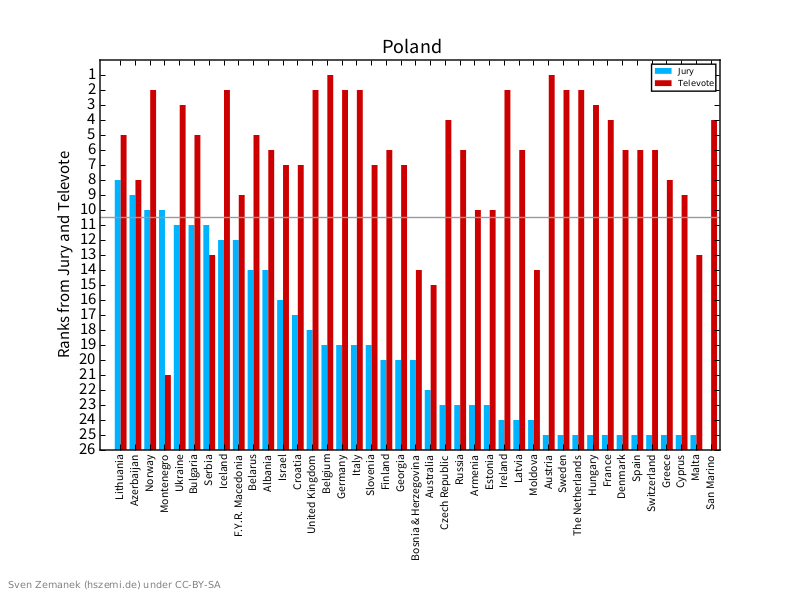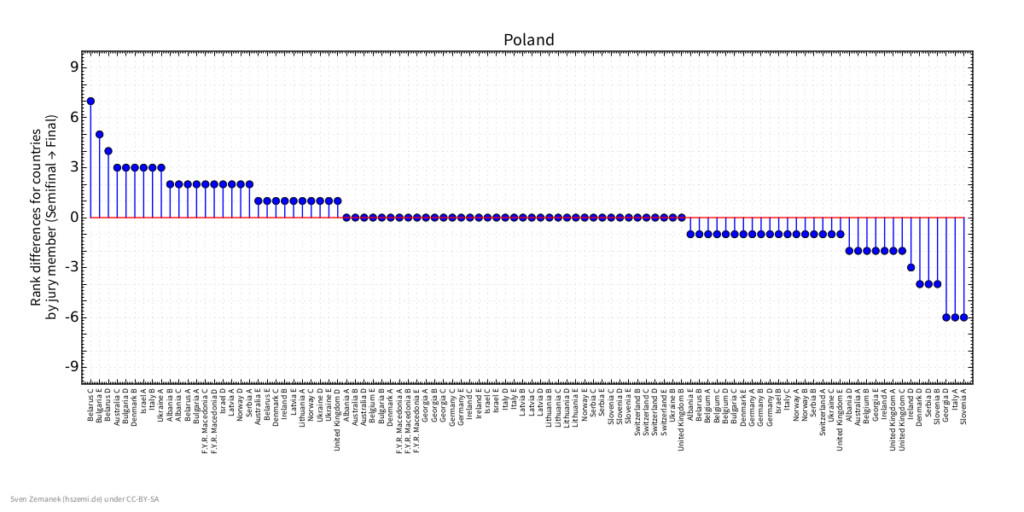Der Eurovision Song Contest 2016 hat stattgefunden. Je nachdem, wen man fragt, hat die Ukraine/Australien/Russland gewonnen. Und aus den gesammelten Ergebnissen, die quasi sofort nach dem Finale auf eurovision.tv veröffentlicht wurden, kann ich wieder tolle Plots generieren.
Warum Australien letztes Jahr gewonnen hätte
Noch in der Finalnacht hatte ich etwas getwittert, und bislang sieht es so aus, als ob ich mich nicht verrechnet habe.
In case you wonder what the result would have been with the old #Eurovision voting system pic.twitter.com/S6UkPeOnjx
— Sven Zemantek (@hszemi) May 15, 2016
Die Abstimmungsregeln, die von 2013 bis 2015 beim ESC galten, hatten eine störende Eigenschaft: Eine sehr schlechte Bewertung durch die Jury eines Landes konnte ein gutes Televoting-Ergebnis negieren, und umgekehrt, da die beiden Rangfolgen zunächst kombiniert wurden, um auf deren Basis dann Punkte zu verteilen. Es war also wichtig, sowohl ein gutes Jury- als auch ein gutes Televoting-Ergebnis im gleichen Land zu erzielen, um möglichst viele Punkte zu sammeln.
Sei 2016 beeinflussen sich Jury- und Publikumsbewertung nicht mehr gegenseitig, sondern werden lediglich am Ende addiert.
Sehen wir uns einmal die Rangverteilungen der drei Top-Beiträge im Finale an: Australien (am meisten Jury-Punkte), Ukraine (Gesamtsieg) und Russland (am meisten Publikumspunkte).
Bei Australien sehen wir, dass die Ränge von Jury (blau) und Publikum (rot) sich relativ ähnlich sind und recht konstant im oberen Bereich bewegen. Russland und Ukraine haben konstant hohe Publikumsbewertungen, die Jurybewertungen fallen aber mehr oder weniger steil ab. Das bedeutet im letztjährigen Verfahren einen Nachteil, da der kombinierte Rang dadurch nach unten gezogen wird.
Beim Gesamtsieg geht es dieses Jahr aber letztlich um die Gesamtlänge der Balken oberhalb der grauen Markierung, unabhängig von deren Farbe. Hier hat die Ukraine dank der besseren Jurybewertungen die Nase vor Russland.
Polen
Hat sich noch jemand bei der Verlesung der Publikumswertungen wenig dafür interessiert, was in den oberen Rängen passiert, sondern nur darauf geachtet, dass Polen immer noch mit 7 Jury-Punkten auf dem letzten Platz auf seine Publikumspunkte wartet?
- What color is your chart? Not blue, that’s for sure!
- Elfmal auf dem vorletzten Jury-Rang? Das ist hart.
Und dann ging es – huiii! – mit 222 Publikumspunkten nach vorn auf den achten Platz. Möglich macht so etwas die neue Art der Punkteverkündigung.
Doch was war da passiert? Im Halbfinale hatte es noch Jury-Punkte für Polen gegeben. Viele Jurorinnen und Juroren der Länder, aus denen es im Halbfinale noch Jury-Punkte für Polen gab, sind in der folgenden Grafik in der rechten Hälfte. Das bedeutet, dass sie Polen im Finale im Vergleich zu den restlichen Ländern aus Halbfinale 2 weiter hinten einsortiert haben. Beachtet man, dass der Beitrag auch ungefähr genauso so oft weiter nach vorn sortiert wurde, ist das alles wohl einfach nur ungünstig gelaufen.
Den entgegengesetzten Fall zu Polen gibt es auch: Die Jurys fanden die schwangere Sängerin im goldenen Kleid aus Malta und den Herrn mit dem breiten Kinn aus Israel ganz toll, das Publikum war weniger beeindruckt. Das fiel aber nicht so stark auf, die beiden Länder haben einfach auf der linken Bildschirmhälfte früh ihre Punkte bekommen.
- Walk on water: Viel blau im Diagramm.
- Twinkle twinkle little star! Jurypunkte hamwa da!
Und sonst so
Deutschland könnten wir noch zeigen:

Schaug an. Da sind wohl viele Deitsche in die angrenzenden DACH-Staaten gefahren und haben von da aus angerufen.
Und die arme Tschechei:
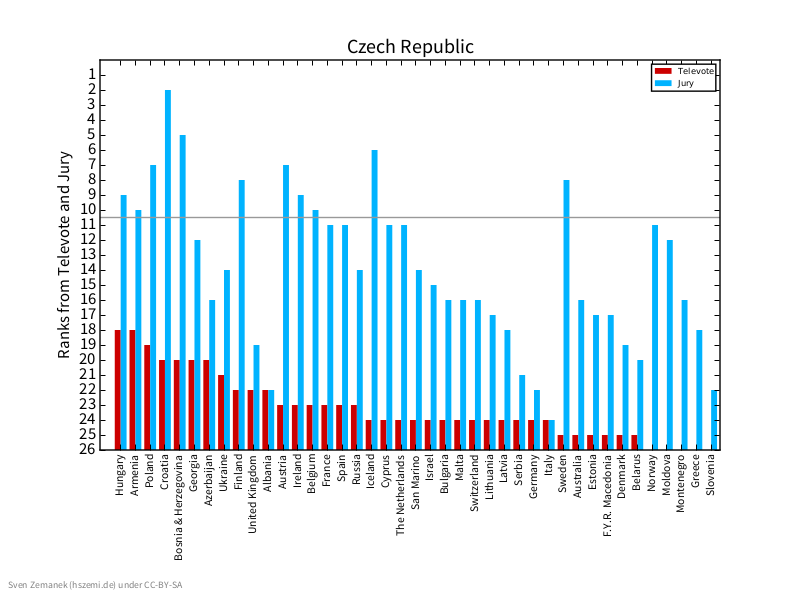
Nur Punkte von den Jurys – das ist ja noch bitterer als Deutschland.
Zu guter Letzt:
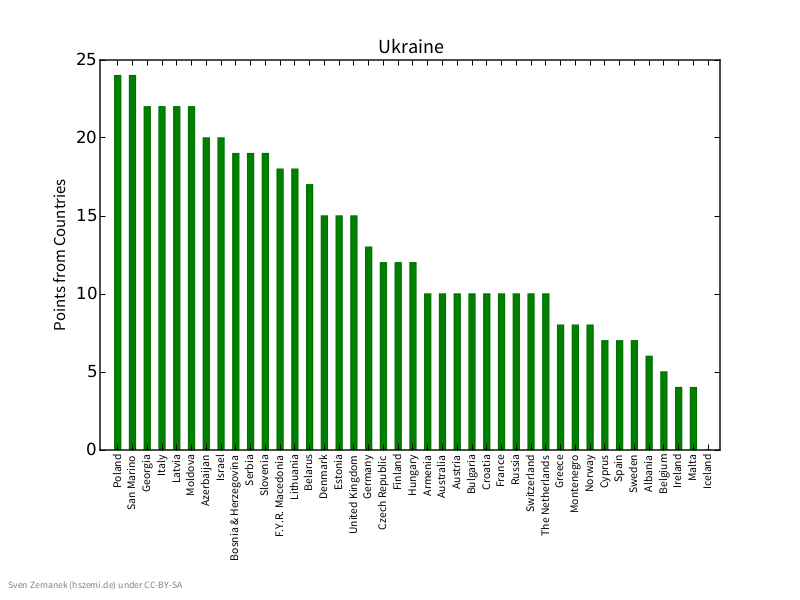
Na wer hat denn da dem Siegertitel keine Punkte gegeben im Finale? Was war da los, Island?
